Watch Out, Bug! These Plants Are Hungry
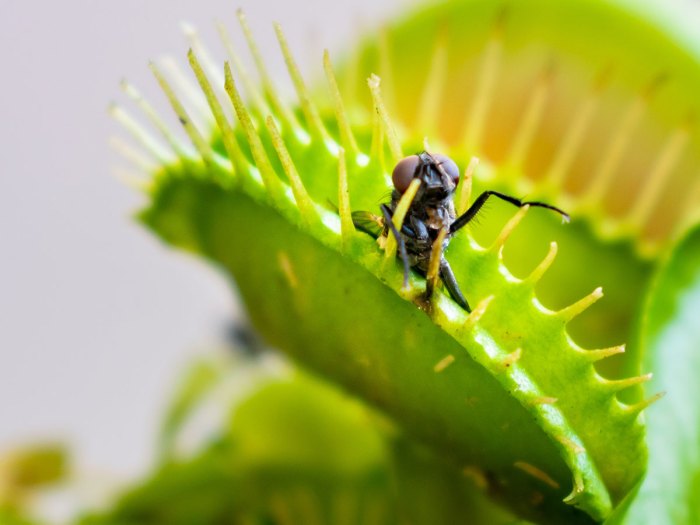
The scientific name for the Venus flytrap is Dionaea muscipula. It was named for the Greek goddess Diana (whom the Romans called Venus). Muscipula means “mousetrap.”
We don’t usually think of plants as predators, but some plants do eat insects and other small creatures. Since they can’t chase prey, these carnivorous (meat-eating) plants have developed some clever strategies to capture their food.
Of the hundreds of thousands of plant species, there are only about 800 that are carnivorous. They typically grow in wetlands or forests where soils are wet for at least part of the year.
These soils are often poor in nutrients, so plants that get much of their energy from sunlight through photosynthesis need to supplement their diet with insects and other prey.
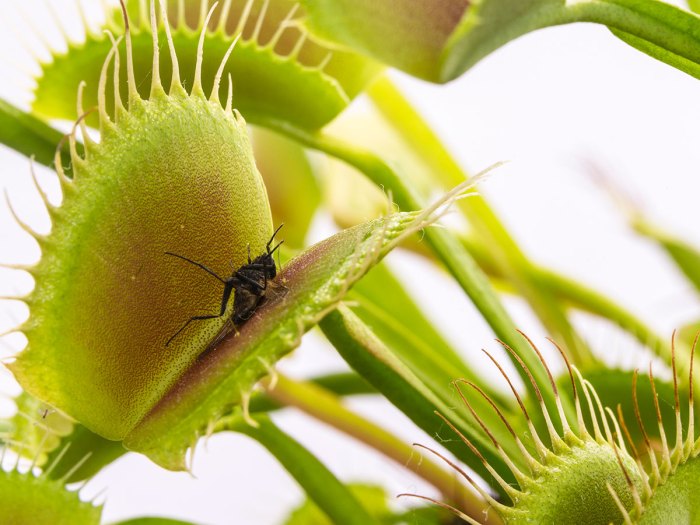
It takes only about 0.3 seconds for the Venus flytrap’s leaves to snap shut and trap prey inside.
VENUS FLYTRAPS
The Venus flytrap is probably the most famous carnivorous plant. Native only to a small area in coastal North and South Carolina, it has been established elsewhere in the U.S. Despite the name, Venus flytraps eat mostly spiders; crawling insects like ants; and smaller amounts of beetles, grasshoppers and other insects.
The Venus flytrap’s hinged “snap traps” are leaves that look like little clams with big eyelashes. The inner surfaces are bright red to purple (to attract insects) and have tiny hairlike projections called “cilia.” When triggered by a bug, the cilia cause the two lobes of the trap to quickly shut, trapping the prey inside. The cilia have to be touched at least twice so the plant doesn’t waste energy on a false alarm. Once a bug is caught, it takes three to 20 days to be digested and for the trap to reopen.
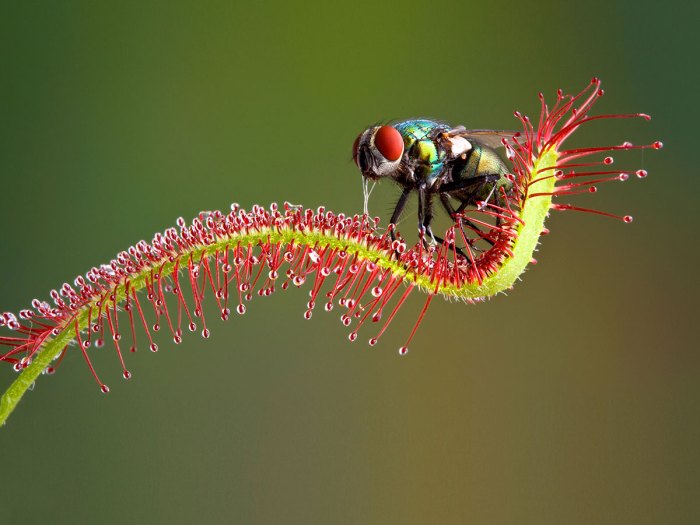
A blow fly is trapped on a carnivorous sundew plant.
SUNDEWS
Sundews, which are Venus flytrap relatives, are some of the world’s smallest predatory plants. They are low-growing and have greenish to reddish paddle-shaped leaves arranged in a circle. Sundews use a “flypaper” approach to trap prey. Their leaves are covered in tiny hairs that release a clear, sticky substance, which both lures and traps bugs. Their name comes from the sticky liquid that makes the plants look like they are covered in dew.
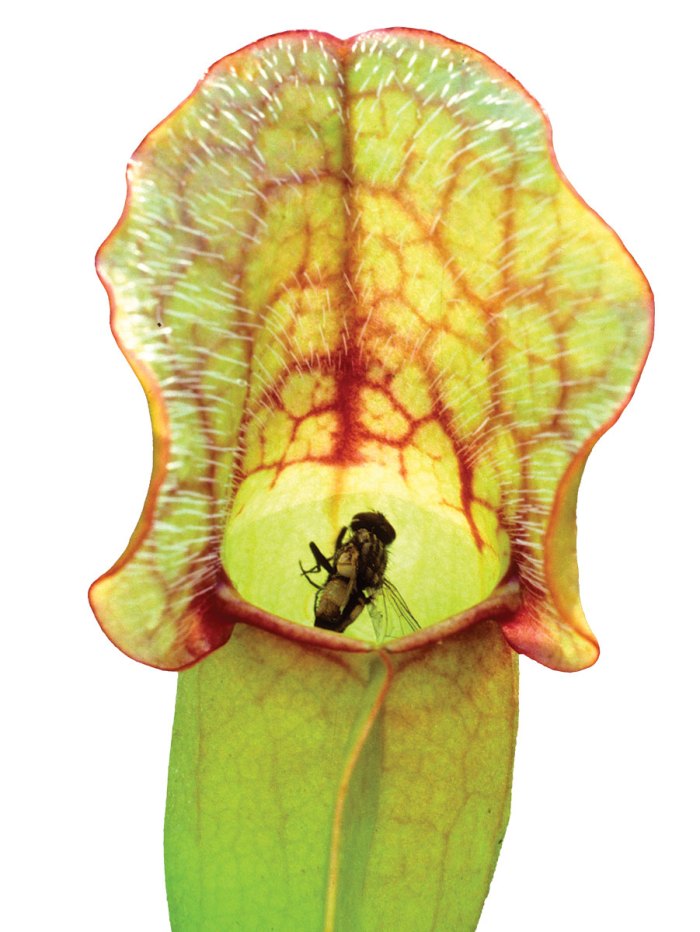
A crimson pitcher plant. Some nicknames for pitcher plants are trumpet pitchers, frog britches and whip-poor-will boots.
PITCHER PLANTS
Pitcher plants are found on four continents. In North America, they grow mainly in the eastern U.S., but some grow on the West Coast and in parts of Canada. The name comes from their tubular shape — the “pitchers” are leaves that function like a pitfall trap.
Pitcher plants lure insects with their bright colors; some also use sugars and odors. The pitcher tops are slippery, and if prey get too close and fall in, it’s hard for them to escape. The victims drown in the pitchers’ liquid, which includes enzymes for digestion. Pitcher plants are unique among carnivorous plants in that they also act as shelter for some wildlife that are able to avoid getting caught, including insects, spiders, frogs and even bats.
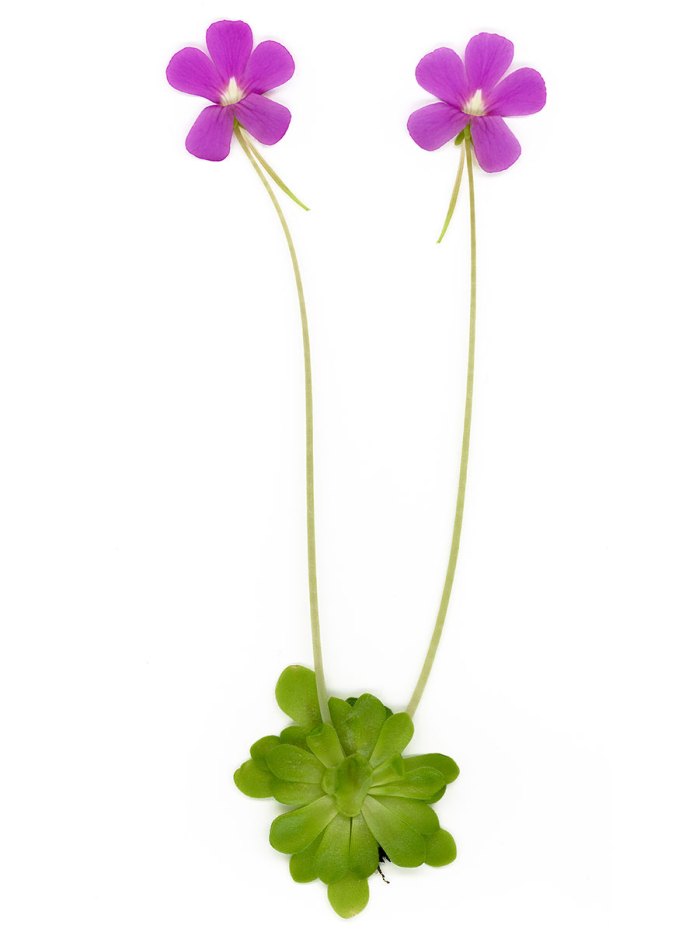
Pinguicula ‘Weser’ butterwort
BUTTERWORTS AND BLADDERWORTS
Butterworts grow in many parts of the world including North America. Their leaves are succulent (they hold water) and arranged in a circular pattern. Butterworts use a flypaper strategy and catch insects with sticky leaves. And, like sundews, prey is digested on the leaf surface where they are caught. Butterworts also produce a substance that keeps insects from rotting while being digested.
Bugs and other invertebrate animals aren’t even safe out on the water. Some carnivorous plants called bladderworts are fully aquatic, and others grow in wet soils. Bladderworts use suction-like traps called “bladders” to catch tiny insects and aquatic worms. The bladders are hollow and have a flexible door and hair-like triggers that suck prey inside. Within about 30 minutes, the traps are reset again.
PROTECT RARE PLANTS
Many carnivorous plants are now rare or endangered in their native range due to poaching, which is the illegal taking of plants (and animals) from the wild. You can help protect rare plants by not removing them from their habitats and always purchasing plants grown by reputable retailers (make sure they are grown in nurseries). Other serious threats to carnivorous plants include over-collecting, habitat loss and drought caused by climate change. Learn more about carnivorous plants at a local botanical garden or arboretum.
Leave a Comment